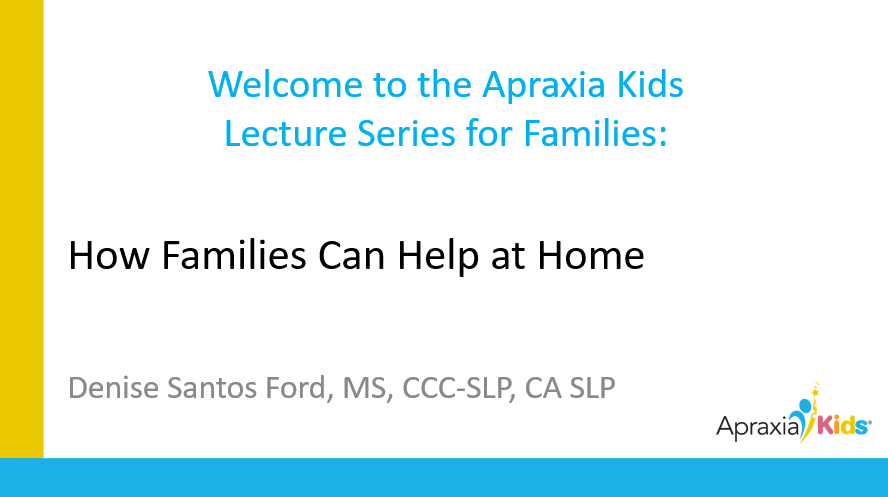
30 Jan How Families Can Help at Home
Course Abstract:
Treatment for childhood apraxia of speech (CAS) requires frequent and intense therapy sessions. While some families may be able to fit ideal therapy schedules into their financial and everyday life, not to mention find a therapist with enough availability for adequate treatment, others may struggle to match ideal with reality. Whether your child attends therapy once a week or 5 days a week, most of their time is spent outside of the therapy room.
This course discussed ways to incorporate therapy into everyday life. Participants were taught effective ways to implement home and school carryover. Caregivers were taught how to support treatment in general and gain ideas to share with their child’s therapist. Attendees learned how to encourage positive practice without pushing too much. Furthermore, this session defined positive practice and stressed its importance. Home practice can be fun and functional.
Presented By:
Denise Santos Ford, MS, CCC-SLP, CA SLP, Recognized by Apraxia Kids for Advanced Training and Expertise in Childhood Apraxia of Speech
Target Audience:
Families/Caregivers
This course is offered for 0.10 ASHA CEUs (Introductory Level, Professional Area)
Learning Objectives:
- List at least 2 carryover activities for caregivers.
- List at least 2 different means of sharing carryover material.
- State the importance of positive practice.
Agenda:
- Presentation (60 Minutes)
- Carryover activity ideas that caregivers can do at home
- Means of sharing carryover material
- Importance of positive practice
- Discussion (15 Minutes)
- Speakers, facilitators, and attendees discussed the session, shared resources and ideas, and asked/answered questions.
Course Abstract:
Treatment for childhood apraxia of speech (CAS) requires frequent and intense therapy sessions. While some families may be able to fit ideal therapy schedules into their financial and everyday life, not to mention find a therapist with enough availability for adequate treatment, others may struggle to match ideal with reality. Whether your child attends therapy once a week or 5 days a week, most of their time is spent outside of the therapy room.
This course discussed ways to incorporate therapy into everyday life. Participants were taught effective ways to implement home and school carryover. Caregivers were taught how to support treatment in general and gain ideas to share with their child’s therapist. Attendees learned how to encourage positive practice without pushing too much. Furthermore, this session defined positive practice and stressed its importance. Home practice can be fun and functional.
Presented By:
Denise Santos Ford, MS, CCC-SLP, CA SLP, Recognized by Apraxia Kids for Advanced Training and Expertise in Childhood Apraxia of Speech
Target Audience:
Families/Caregivers
This course is offered for 0.10 ASHA CEUs (Introductory Level, Professional Area)
Learning Objectives:
- List at least 2 carryover activities for caregivers.
- List at least 2 different means of sharing carryover material.
- State the importance of positive practice.
Agenda:
- Presentation (60 Minutes)
- Carryover activity ideas that caregivers can do at home
- Means of sharing carryover material
- Importance of positive practice
- Discussion (15 Minutes)
- Speakers, facilitators, and attendees discussed the session, shared resources and ideas, and asked/answered questions.
Credentials:
Hours of Operation:
Treatment locations:
Address:
,
Phone:
Email:
Overall Treatment Approach:
Percent of CAS cases:
Parent Involvement:
Community Involvement:
Professional consultation/collaboration:
Min Age Treated:
Max Age Treated:
Insurance Accepted:





